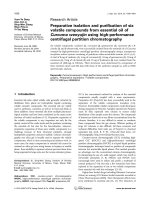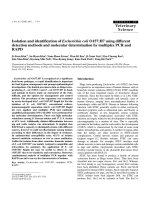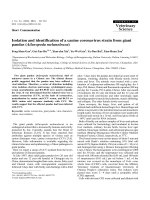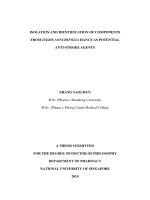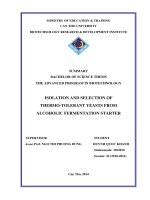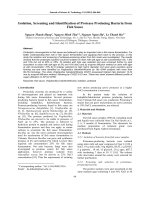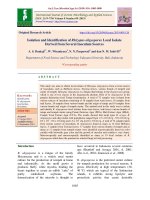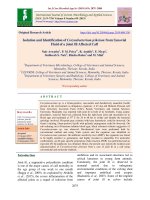Isolation and identification of agar degrading microorganisms from diverse environments in vietnam (khóa luận tốt nghiệp)
Bạn đang xem bản rút gọn của tài liệu. Xem và tải ngay bản đầy đủ của tài liệu tại đây (1.86 MB, 66 trang )
VIETNAM NATIONAL UNIVERSITY OF AGRICULTURE
FACULTY OF BIOTECHNOLOGY
THESIS
TITLE:
ISOLATION AND IDENTIFICATION OF AGARDEGRADING MICROORGANISMS FROM DIVERSE
ENVIRONMENTS IN VIETNAM
Hanoi, 1/2021
VIETNAM NATIONAL UNIVERSITY OF AGRICULTURE
FACULTY OF BIOTECHNOLOGY
THESIS
TITLE:
ISOLATION AND IDENTIFICATION OF AGARDEGRADING MICROORGANISMS FROM DIVERSE
ENVIRONMENTS IN VIETNAM
Student
: Vu Thi My Duyen
ID
: 610710
Department
: Biotechnology
Supervisor
: Vu Nguyen Thanh, Assoc. Prof.
Nguyen Van Giang, Assoc. Prof.
Hanoi, 1/2021
COMMITMENT
I hereby declare that:
This is my study, which was conducted under the guidance of the supervisors;
All data provided are true and accurate;
All published data and information have been duly cited.
Hanoi, January 2021
Student
Vu Thi My Duyen
i
ACKNOWLEDGEMENTS
Firstly, I am grateful to express my gratitude to the Food Industries Research
Institute, especially to the Center for Industrial Microbiology for granting me support
to pursue my thesis as well as to the Department of Biotechnology, Vietnam National
University of Agriculture, who provided me opportunities to pursue higher education
and to prepare myself to better.
I also would like to express my gratitude to my supervisor Assoc. Prof. Nguyen
Van Giang for providing me with an opportunity to do the final work in the Vietnam
National University of Agriculture and giving me all support, which made me
complete the project.
I owe my deep gratitude to Assoc. Prof. Vu Nguyen Thanh, who has given me
all support, guidance, all the necessary information that made me complete the project.
He allowed me to do the necessary research work and use the lab equipment needed at
the Center for Industrial Microbiology, Food Industries Research Institute. Besides, I
would like to extend our sincere esteems to all members in the laboratory for their
timely support.
It also gives my thankfulness to my family, to all of my friends, for sharing my
difficulties, and giving me various useful pieces of advice during the process of
learning and studying.
Thank you very much!
Hanoi, 2nd February 2021
Student
Vu Thi My Duyen
ii
TABLE OF CONTENTS
COMMITMENT ..............................................................................................................i
ACKNOWLEDGEMENTS ........................................................................................... ii
TABLE OF CONTENTS .............................................................................................. iii
LIST OF FIGURES .........................................................................................................v
LIST OF TABLES .........................................................................................................vi
ABBREVIATIONS ...................................................................................................... vii
ABSTRACT ................................................................................................................ viii
I. INTRODUCTION ........................................................................................................1
II. LITERATURE REVIEW .......................................................................................... 3
2.1. Introduction of agar ..................................................................................................3
2.1.1. Agar structure ........................................................................................................3
2.1.2. Agar source ............................................................................................................4
2.1.3. Properties of agar ...................................................................................................4
2.2. Agarolytic microorganisms ......................................................................................5
2.3. Agar-degrading enzymes .......................................................................................... 6
2.3.1. Agarase source .......................................................................................................6
2.3.2. α-Agarase ...............................................................................................................7
2.3.3. Applications of agarases ......................................................................................11
2.4. Agar production and agar-degrading enzymes research in Vietnam .....................13
III. MATERIALS AND METHODS ............................................................................15
3.1. Study laboratory and time ......................................................................................15
3.2. Materials .................................................................................................................15
3.2.1. Samples for isolation .......................................................................................... 15
3.2.2. Chemicals ............................................................................................................15
3.2.3. Equipment ............................................................................................................16
3.2.4. Media ...................................................................................................................16
3.3. Research methods (Fu and Kim, 2010) ..................................................................17
3.3.1. Sample enrichment .............................................................................................. 17
3.3.2. Method of isolation.............................................................................................. 17
iii
3.3.3. Purification and maintenance of isolates ............................................................. 17
3.3.4. Observation of colonies and cells ........................................................................17
3.3.5. Gram staining ......................................................................................................17
3.3.6. Protein fingerprinting by SDS-PAGE method ....................................................19
3.3.7. DNA extraction and purification .........................................................................20
3.3.8. rDNA sequencing ................................................................................................ 21
3.3.9. DNA electrophoresis ........................................................................................... 21
3.3.11. Agarase assay by Congo red staining ............................................................... 21
IV. RESULTS AND DISCUSSION .............................................................................23
4.1. Isolation results .......................................................................................................23
4.2. Selection of agar degrading microorganisms ......................................................... 25
4.3. Observation of colonies, cells.................................................................................27
4.4. Grouping by protein fingerprinting ........................................................................29
4.5. Identification of microorganisms by rDNA sequencing ........................................31
V. CONCLUSION AND SUGGESTION .....................................................................35
5.1. Conclusion ..............................................................................................................35
5.2. Suggestion ..............................................................................................................35
REFERENCES ..............................................................................................................36
ANNEX ......................................................................................................................... 39
iv
LIST OF FIGURES
Figure 2. 1. Structure of agarose. ....................................................................................3
Figure 2. 2. Diagram of the cleavage site of agarase (Kazłowski, Pan and Ko,
2008). ....................................................................................................................7
Figure 2. 3 Strategies for agarose hydrolysis and the various physiological
activities of agarose-derived sugars. ..................................................................12
Figure 4. 1. Some kinds of samples. ..............................................................................23
Figure 4. 2. Isolation origins of 109 agar-degrading strains. ........................................24
Figure 4. 3. Enrichment samples were transferred on agar medium at 28 °C
after 10 days. ......................................................................................................24
Figure 4. 4. The morphology of agar-degradable microorganisms. Bar, 5µm. .............28
Figure 4. 5. Electrophoresis images of Protein fingerprinting products of 79
strains. .................................................................................................................29
Figure 4. 6. Neighbour-joining phylogram depicting the relationships between
isolated strains and neighbouring taxa. .............................................................. 32
Figure 4. 7. Pie chart comparing frequency appears of microorganisms
degrading agar in different samples in Vietnam. ...............................................33
Figure 4. 8. Congo red staining results of strains cultured on MSYA agar at 28 °
C after 7 days. .....................................................................................................25
v
LIST OF TABLES
Table 2. 1. Some agarolytic microorganisms: origins and characteristic of the
enzyme ..................................................................................................................6
Table 2. 2. Characterization of some recombinant β-agarases (Veerakumar and
Manian, 2018).......................................................................................................9
Table 3. 1. Experimental content ...................................................................................15
Table 4. 1. Isolation results............................................................................................ 23
Table 4. 2. Group of isolated strains by morphology and protein fingerprinting
results ..................................................................................................................30
Table 4. 3. Qualitative agarase activity of representative strains. .................................26
vi
ABBREVIATIONS
Abbreviations
Full name
DNA
Deoxyribose nucleic acid
PCR
Polymerase chain reaction
rDNA
Ribosomal DNA
TAE
Tris-acetate-EDTA
MSYA
Minimal salt yeast extract agar
CBB
Coomassie Brilliant Blue
AOS
Agarooligosaccharides
NAOS
Neoagarooligosaccharides
vii
ABSTRACT
In this study, samples were collected from regions in Vietnam to isolate agardegrading microorganisms. As we know agar production process still has many
shortcomings such as causing environmental pollution, high production costs, etc. The
research direction of using biotechnology to agar production is currently being
interested, in particular the use of enzymes from microorganisms. The thesis research
for agar-degrading microorganisms, target to produce secondary products of higher
value agar, and searched for microorganisms capable of producing enzymes that cut
agar into other products such as AOS- agar oligosaccharides and NAOSneoagarooligosaccharides. These products are used in pharmaceuticals and cosmetics.
From 90 samples collected, 109 agar-degrading microorganisms were isolated
using morphology and protein fingerprinting method, 44 representative strains
randomly of each group one or two strains selected from 61 groups for 16S sequence
analysis. The results of the sequence analysis identified 19 species including
Microbulbifer elongatus, Enterobacter huaxiensi, Alteromonas abrolhosensis, Bacillus
flexus, Bacillus tenquilensis, Catenococcus thiocycli, Luteibacter jiangsuensis,
Lysinibacillus fusiformis, Microbacterium
aquimaris, Nitratireductor
indicus,
Paracoccus homiensis, Pseudomonas pachastrellae, Salipiger pacificus, Pseudomonas
plecoglossicida, Shinella curvata, Sinomicrobium oceani, Shingopyxis granuli,
Stappia indica, and Advenellas kashmirensis. Four undescribed species of the genera
Bacillus, Microbacterium, Microbulbifer, and Shingopyxis have been identified. The
agarolytic activity of the strains was also investigated.
I. INTRODUCTION
Agar, mainly extracted from the species of marine red algae including Gelidium
and Gracilaria, is a polysaccharide well known as an important gelifying agent for the
food, cosmetic, and medical industries, and is composed of agarose and agaropectin.
However, the current agar production process still has many shortcomings such as
causing environmental pollution, high production costs, etc. The research direction of
using biotechnology to agar production is currently being interested, in particular the
use of enzymes from microorganisms.
A number of agar-hydrolyzing bacteria have been isolated from marine and
other environments and several agarases have been purified and characterized in the
past
decade
from
Pseudoalteromonas,
isolates
of
Streptomyces,
Cytophaga,
Vibrio,
Pseudomonas,
Agarovirans,
Alteromonas,
Saccharophagus,
Microscilla, etc. Agarases catalyze agar hydrolysis and include two types, α-agarase
and β-agarase depending on the pattern of its cleavage. Agarooligosaccharides are
produced when α- agarases cleave α-1,3 linkages of agar polymer and
neoagarooligosaccharides are produced when β-agarases cleave β-1,4 linkages of agar
polymer.
Agar-derived
sugars,
including
agar
oligosaccharides
and
neoagarooligosaccharides, have industrial potentials as pharmaceuticals, prebiotics,
and cosmetic ingredients owing to their various physiological activities.
Agarases have been applied in a wide range of biotechnological and industrial
applications. Agarases have been used for agar hydrolysis to produce oligosaccharides
which have essential physiological and biological activities that are helpful for human
health. Agarase was also applied in DNA purification from agarose gel. Protoplasts
from seaweeds have been obtained by using agarase, and for understanding the
composition and structure of the cell wall of seaweeds. Thus, isolating microorganisms
producing agarase would be of great importance in providing a valuable understanding
of this enzyme, also widening the use of this enzyme in medical, cosmetic, life
sciences, and industrial fields.
In this study, the research topic "Isolation and identification of agardegrading microorganisms from diverse environments in Vietnam" was conducted to
1
understand the diversity of the group of microorganisms, and exploring novel species
for various applications.
Research objective
The objective of this research is to understand the diversity of agar-degrading
microorganisms in Vietnam.
More specifically:
-
To isolate agar-degrading microorganisms from diverse environments like soil,
plants, seaweeds …
-
To identify the isolates by rDNA sequencing
-
To determine the agar-degrading activity of the isolates.
2
II. LITERATURE REVIEW
2.1. Introduction of agar
2.1.1. Agar structure
Agar is a type of heterogeneous polysaccharide whose main component is
agarose, accounting for about 70%, the rest is agaropectin. Agarose is a linear polymer
consisting of alternating two molecules β-D-galactose and 3,6-anhydro-α-Lgalactopyranose, linked together by 1,3-linked β-d-galactose (neoagarobiose) and 1,4linked 3,6-anhydro-α-l-galactose (agarobiose) (Figure 2.1) (Zucca, FernandezLafuente and Sanjust, 2016). Whereas agaropectin is a heterogeneous mixture with a
short-chain structure, the composition is similar to agarose and has additional bonds
with -OSO3-, -OCH3, glucuronate, or pyruvate… at the C2 or C6 position of the 3,6anhydro-α-L-galactose molecule. The physical properties of agar are closely related to
its chemical properties like agar gel strength depends greatly on the ratio of agarose
and agaropectin as well as the composition of the bonding groups.
Figure 2. 1. Structure of agarose.
In mass terms, agarose has a high molecular weight of above 100 kDa. While
an agaropectin molecule weighs less than 20 kDa, the composition contains from 5 to
8% sulfate, so it is often not used in food processing (Armisen and Galatas, 1987).
However, agaropectin could be modified into agarose by removing the sulfate groups
of agaropectin (Phillips and Williams, 2020). A high concentration of agaropectin is
found in red algae Gracilaria, Porphyra... (Lu et al., 2001).
3
2.1.2. Agar source
Agar is mainly extracted from the cell walls of the red algae Gelidium and
Gracilaria. Gelidium is a good source of agar but these species are small, slowgrowing plants, and only well-cultivated in a few countries and regions. Whereas
Gracilaria species are capable of growing rapidly and cultivated widely in the world.
Thus, Gracilaria has become the most important source of agar production (Armisen,
1995)
2.1.3. Properties of agar
Agar is a mixture of agarose and agaropectin in different proportions depending
on the alga species of raw materials and manufacturing process. Therefore, different
types of agar have not similar properties, but all types of agar have some physical and
chemical properties (Hải, 2016)
Solubility: Agar is insoluble in cold water, but it swells considerably. It is
slightly soluble in ethanolamine and well soluble in formamide. Agar is
soluble in water and other solvents at temperatures between 95ºC to 100ºC.
Gel-forming ability: Agar forms a gel after being heated and cooled without
the addition of gel-forming agents, while carrageenan needs potassium or
protein to form gels, alginate needs calcium or divalent cations. The agarose
molecules change from a coil structure to the helices. Gel-forming ability and
gel strength depend on the agar concentration and the average molecular
weight (the larger the average molecule, the more stable the gel is formed). A
solution containing 1.5% agar begins to gel at 32 - 43°C and will not melt
below 85ºC. This gel-forming ability has led to a large number of practical
applications where agar is used as a food additive or in other applications in
microbiology, biochemistry, or molecular biology, as well as in industrial
applications.
Viscosity: Agar viscosity depends on the agaropectin content of the raw
material. In general, the viscosity of agar is relatively stable at pH 4.5-9.0.
Agar can be used well in the pH range of 5-8.
4
Stability: Agar is capable of reversing gelation and melting at high
temperature without changing the initial properties. Agar in the dry state is
not subject to contamination by microorganisms.
Thanks to the above properties, agar is often used in food processing
technology such as a substitute for processed cheese or as an additive to baked goods,
confectionery, products from meat and dairy products... Agar is a polysaccharide that
is indigestible to most microorganisms and should be used as a culture medium.
Besides, agar has been experimented on producing agar-soybean protein biofilm for
enhanced chemical and physical properties. Agar is also used in the textile industry,
functional foods, and other applications. With its useful properties in smart materials
development for composites and adsorption applications, agar is believed to become a
promising material in the future (Chew et al., 2018).
2.2. Agarolytic microorganisms
The first agarolytic bacterium was isolated from seawater at the beginning of
the 20th century by Gran, 1902. Since then, a number of microorganisms have been
reported to degrade agars, mainly in the marine environment, either in the water
column, in coastal marine sediments, or associated with red algae (Humm, 1946),
(Stanier, 1941). Agarolytic bacteria have also been identified in brackish water and salt
marshes (Ekborg et al., 2005) and, more surprisingly, in freshwater (Van der Meulen,
Harder, and Veldkamp, 1974) and soils (Buttner et al. 1987), (Suzuki et al., 2003)).
This unexpected presence of agarases in non-marine environments was also confirmed
by the metagenomic approach on soil samples (Voget et al., 2003). Despite the number
of isolated species, the agarolytic bacteria represent only a few phyla and classes.
Those marine microorganisms mainly belong to the Gammaproteobacteria class of the
Proteobacteria
phylum,
Pseudoalteromonas,
including
Vibrio,
the
genera
Alterococcus,
Pseudomonas,
Microbulbifer,
Alteromonas,
Agarivorans,
Thalassomonas, and Saccharophagus. Agarolytic bacteria are also found in the three
classes of the Bacteroidetes phylum, the Bacteroides class including the genus
Marinilabilia, the Flavobacteria class including the genera Flavobacterium,
Cellulophaga, and Zobellia, and the Sphingobacteria class including the genera
Cytophaga, Persicobacter, and Microscilla. In soils, the agarolytic microorganisms are
5
gram-positive bacteria belonging to the Actinobacteria and Firmicutes phyla (Michel
et al., 2006). Almost no studies have reported on agarase biosynthesis from mycelium
and yeast. Most agarases are produced extracellularly, except a few agarases are
produced intracellularly (Fu and Kim, 2010)
Table 2. 1. Some agarolytic microorganisms: origins and characteristic of the enzyme
Source
Seawater
Vibrio sp. JT0107
Alteromonas sp. C-1
Cytophaga sp.
Alteromonas sp. agarlyticus GJ1B
Marine sediment
Vibrio sp. PO-303
Thalassomonas sp. JAMB-A33
Agarivorans sp. HZ105
Marine algae
Alteromonas sp. SY37-12
Pseudoalteromonas antarctica N-1
Pseudomonas atlantica
Vibrio sp. AP-2
Marine mollusks
Agarivorans albus YKW-34
Freshwater
Cytophaga flevensis
Soil
Bacillus sp. MK03
Alteromonas sp. E-l
Acinetobacter sp. AGLSL-1
2.3. Agar-degrading enzymes
Localization
Category (α/β agarase)
extracellular
extracellular
extracellular
extracellular
β
β
β
α
extracellular
intracellular
extracellular
β
α
β
extracellular
extracellular
intracellular
extracellular
β
β
β
β
extracellular
β
extracellular
β
extracellular
intracellular
extracellular
β
β
β
2.3.1. Agarase source
Agarase is an enzyme in the glycoside hydrolase group capable of hydrolyzing
the agar to low molecular weight products. Agarase is divided into two enzymes: αagarase (EC 3.2.1.158) α-1,3-glycoside cleavage and β-agarase (EC 3.2.1.81)-1,4glycoside in agar endothelium produces oligosaccharides (Figure 1.3). β-Agarase was
more
commonly
found
than
α-agarase
( />
6
on
the
CaZy
database
Figure 2. 2. Diagram of the cleavage site of agarase (Kazłowski, Pan and Ko, 2008).
Several agarases have been found from a variety of sources including seawater,
marine sediments, marine algae, marine molluscs, freshwater, soil... Their molecular
weights vary widely from 20 to 360 kDa. The smallest enzyme with a molecular mass
of about 20 kDa was produced by Vibrio sp. AP-2 isolated from seaweed, while the
largest enzyme that weighs approximately 360 kDa was found in Alteromonas
agarlyticus GJ1B from seawater. Most agarases have a polypeptide chain, except for
the enzyme from Alteromonas agarlyticus GJ1B.
In freshwater and on land, the molecular weight of agarase from the freshwater
bacteria Cytophaga flevensis is about 26 kDa, while the enzymes from the soil have a
much greater mass of 100 kDa in Acinetobacter sp. AGLSL-1, 113 kDa in Bacillus sp.
MK03 and 180 kDa in Alteromonas sp. E-l. In which, agarase from Acinetobacter sp.
AGLSL-1 has a specific activity of 397 U/mg, the highest of all the enzymes published
before 2010. All four enzymes belong to the β-agarase group (Lakshmikanth, Manohar
and Lalitha, 2009).
2.3.2. α-Agarase
α-Agarase cleaves the α-1,3 bond to form short agar oligosaccharide chains
containing 3,6-anhydro-L-galactose at the reducing end and the final product
agarobiose. Currently, more than 10 α-agarase enzymes have been isolated from
seawater and marine sediments, all of which belong to the agarose cleavage GH 96
family to create the final product, agarotetraose. Of which only 5 α-agarase has been
studied for properties, derived from (1) Alteromonas agarlyticus GJ1B, (2)
7
Thalassomonas sp. JAMB-A33, (3) Thalassomonas sp. LD5, and (4) Catenovulum
agarivorans, (5) Catenovulum sediminis WS1-A (Flament et al., 2007) (Hatada, Ohta
and Horikoshi, 2006) (Lee, Lee and Hong, 2019) (Liu et al., 2019). However, there
have been no studies on the catalytic structure of α-agarase, but only the structure
similar to the cellulose-VI adhesion region of type VI on the protein database (NCBI)
has been determined.
Among 10 α-agarase have found, 4 recombinant enzymes investigated their
characteristic, the results are presented in Table 1.1. The enzyme rAgaA33 was cloned
from a bacterium Thalassomonas sp. JAMB-A33 isolated from deep-sea sediments
and expressed extracellularly on Bacillus subtilis bacteria with a size of about 85 kDa
and specific activity of 40.7 U/mg (Hatada, Ohta and Horikoshi, 2006). In 2018,
Zhang e successfully expressed α-agarase from Thalassomonas sp. LD5 on E. coli
with the enzyme activity of 5 U/ml in culture solution and 149 U/mg after
concentration, optimal activity at 350C, pH 7.4 (Zhang et al., 2018). Compared with
natural agarase, the properties of this enzyme including molecular weight, specific
activity, optimum temperature and pH, and hydrolysis product are all without
differences. Thus, recombinant α-agarase can be formed by recombination with high
efficiency and retains its natural properties.
2.3.3. β-Agarase
β-Agarase cleaves the β-1,4 bond to form short neoagarooligosaccharide vessels
containing D-galactose at the reducing end and the final product is neoagarobiose. The
amino acid sequence comparison showed that β-agarase was classified into 4 families
of Glycoside Hydrolases: GH-16, GH-50, GH-86, and GH118. The GH-16 family is
the most common consisting of β-agarase, carrageenase, glucanase, galactosidase,
laminarinase ... found in eukaryotes, while β-agarase is the only enzyme group in the
GH-50 family and GH-118 and recently found in prokaryotes; family GH-86 has
added β-porphyranase. These agarases almost all have conservative glycoside
hydrolase catalytic zones, and some carbohydrate adhesion zones (CBM).
Recombinant β-agarase was mainly expressed intracellularly on E. coli, while
B. subtilis was used to express recombinant agarase from Microbulbifer-like JAMBA94, Agarivorans sp. JAMB-A11, Microbulbifer thermotolerans JAMB-A94, and
8
Microbulbifer sp. JAMB-A7 and significantly higher activity than the E. coli
expression system. Another β-agarase named Sco3487 from Streptomyces coelcolor
A3 (2) was expressed on the bacteriophage Streptomyces lividans TK24, the
recombinant enzyme with a molecular weight of 83.9 kDa and optimal activity at 40 °
C, pH 7, 0. A special feature of this enzyme is that it belongs to the GH50 family and
has both agarose intracellular and extracellular cleavage properties. The resulting
products include neoagarotetraose, neoagarohexaose, and neoagarobiose (Lee, Lee and
Hong, 2019). In addition, a gene that encodes β-agarase BN3 from Micrococcaceae sp.
was cloned and expressed in Pichia pastoris GS115. The molecular weight of this
agarase ranges from 35 to 100 kDa, optimal activity in pH 7.0 at 450C, specific activity
is 1120 U/mg much higher than the other combinations (Xu et al., 2018).
Table 2. 2. Characterization of some recombinant β-agarases (Veerakumar and Manian,
2018)
Gene
AgaG1
YM01-3
AgaH71
AgaB1
Bacterium
Alteromnas sp.
GNUM-1
Catenovulum
agarivorans
YM01T
Pseudoalteromon
as hodoensis H7
Thalassomonas
agarivorans
BCRC 17,492
Source of the
bacterium
Optimum
pH
Optimum
Temperature
( oC)
pH
stability
Temperature
stability
Marine algae
7
40
7-8
25-45oC
Sea water
6
60
4-9
<50oC
Coastal sea water
6
45
5-9
45-50oC
Seawater
7.4
40
7-9
30-40oC
Agy1
Saccharophagus
sp. AG21
Red seaweed
Gelidium
amansii
7.5
55
5-9
45-50oC
AgaXa
Catenovulum sp.
X3
Sea water
7.4
52
5-9
<42oC
Cellvibrio sp.
Activated
sludges
at municipal
sewage plant
6.5
42.5
-
<40oC
Sea water
7
35
6-8
25-45oC
Marine sediment
7
40
-
-
Soil bacterium
7
40
Only at
7
20-40oC
Coastal sediment
7.5
40
7-8.6
<40oC
Soil bacterium
7
40
5-8
25-40oC
Marine
bacterium
7
30
6-9
<40oC
AgaA
AgaJA2
HZ2
Sco3487
AgaAC
N41
DagA
Aga50D
Agarivorans sp.
JA-1
Agarivorans sp.
HZ105
Streptomyces
coe-licolor A3(2)
Vibrio sp. Strain
CN41
Streptomyces
coe-licolor A3(2)
Saccharophagus
degradans 2-40
9
Gene
Bacterium
AgrP
Pseudoalteromonas sp. AG4
AgaA
Pseudoalteromonas sp. Ag52
AgaM1
YM01-1
Aga2
BN3
Aga50A
Aga 50D
and
NABH
agaB
AgaP43
83
AgWH5
0A
Flammeovirga
sp. MY04
Catenovulum
agarivorans
YM01
Cellulophaga
omnivescoria
W5C
Micrococcaceae
sp.
Saccharophagus
degradans 2-40
Flammeovirga
sp. SJP92
Flammeovirga
pacifica
WPAGA1
Agarivorans gilvus WH0801
agaG1
Alteromnas sp.
GNUM-1
AgaYT
Flammeovirga
yaeyamensis
strain YT
Aga672
Aquimarina
agarilytica ZC1
AgaJ5
Gayadomonas
joobiniege G7
ID2563
AgaJ9
AgJ11
Aga16B
Aga4436
AgaH92
Microbulbifer sp.
Q7
Gayadomonas
joobiniege G7
Gayadomonas
joobiniege G7
Saccharophagus
degradans 2-40T
Flammeovirga
sp. OC4
Pseudoalteromonas sp
H9KCTC23887
Optimum
pH
Optimum
Temperature
( oC)
pH
stability
Temperature
stability
5.5
55
4.5-8
<55oC
5.5
55
4.5-9
40-60oC
7
50
5-10
30-60oC
Marine
bacterium
7
50
6-9
<45oC
Marine
bacterium
8
45
5-9
35-55oC
-
7
45
3-9
<45oC
Gracilaria
verrucosa, a red
algae
7
37
6-9
<40oC
-
8
45
-
45-55oC
Deep sea
sediment
9
50
5-10
<40oC
Fresh seaweed
6
30
6
20-40oC
7
40
5-8
37-45oC
8
40
-
-
7
25
7-11
<40oC
Source of the
bacterium
Red algae,
Chondrus
crispus
Red seaweed
Gelidium
amansii
Mangrove
sediment
Surface of
Sargassum
serratifolium
Surface of a red
algae, Gracilaria
tennuistipitata
Surface of
marine red alga
Porphyra
haitanensis
Sea water
4.5
30
4.5-5.5
Retained 40%
of enzymeatic
activity at
10oC
Guts of sea
cucumbers
6
40
6-9
30-60oC
Sea water
5
25
4-8
<30oC
Coastal seawater
4.5
40
4-5
30-40oC
7.5
55
5.5-8.5
45-60oC
6.5
50-55
5-10
30-80oC
6
45
5-9
40-50oC
Marine
bacterium
Deep-sea
bacterium
Marine
bacterium
10
Gene
Bacterium
AgaTM2
AgaA
AgaW
AgWH5
0C
Simiduia sp.
Strain TM-2
Pseudomonas
vesicularis
MA103
Cohnella sp.
Strain LGH
Agarivorans gil-
Source of the
bacterium
Optimum
pH
Optimum
Temperature
( oC)
pH
stability
Temperature
stability
Marine sediment
8
35
-
-
Seawater
-
16,20,24
-
-
Soil
7
50
6-10
<50oC
Fresh seaweed
6
30
6-7
20-30oC
The properties of some recombinant β-agarase have been investigated as shown
in Table 2.2. Their optimal temperature is mostly around 40-550C; except enzymes
from Agarivorans gilvus WH0801, Gayadomonas joobiniege G7, and Saccharophagus
degradans 2-40 which have optimal activity at 300C; Aquimarina agarilytica ZC1 has
optimal activity at 250C; the optimal Catenovulum agarivorans YM01T cloning
enzyme at a temperature of 600C. Most of the recombinant agarose exhibited optimal
activity under either neutral or weakly alkaline pH, except for AgJ11 from
Gayadomonas joobiniege G7 and AgaP4383 from Flammeovirga pacifica WPAGA1,
which showed maximum activity at pH 4.5 and pH, respectively 9.0. Thus, agarases
belonging to the same GH family have similar catalytic properties. And normally, the
end products of agarase in the GH16, GH50, and GH86 families are NA4, NA2, and
NA6/ NA8, respectively (Kang et al., 2003).
2.3.3. Applications of agarases
a. Recovering DNA from agarose gel
Agarases are being used extensively in DNA purification following the agarose
gel electrophoresis. They are indispensable tools in the field of molecular biology. For
instance, Takara Company (Japan) revealed a DNA purification kit from agarose gel
using a β-agarase thermostable up to 60°C. The agarase from Vibrio sp. JT0107 was
determined the relative activity about 60% after the DNA purification from agarose gel
by incubating at 65°C for 5 minutes.
b. Producing agar oligosaccharides
11
Figure 2. 3 Strategies for agarose hydrolysis and the various physiological activities of
agarose-derived sugars.
Agarase has been applied in the production of agar-derived oligosaccharides.
Comparing to the acid hydrolysis method, the enzyme hydrolysis offers many
significant benefits such as environmental friendliness, high efficiency, controllable
products, simple facilities, low production costs...(Li et al., 2007) reported a simple
method of the production of neoagarooligosaccharides (NA) using recombinant
agarases Aga-A and Aga-B cloned from Pseudoalermonas sp. CY24 to generate NA4,
NA6, NA8, NA10, and NA12 (Li et al., 2007).
The agar-derived oligosaccharides have potential applications in food,
pharmaceutical, and cosmetic industries thanks to various physiological activities such
as
prebiotic
effects,
skin
whitening,
antiinflammation,
antioxidation,
hepatoprotection (Figure 2.2) (Yun, Yu and Kim, 2017)
c. Research on seaweed bio-substances and preparation of seaweed protoplasts
12
and
Agarases have potential applications in degrading the red alga cell wall to
extract labile substances with biological activities such as unsaturated fatty acids,
vitamins, carotenoids. Besides that, agarases have also been used to prepare
protoplasts from marine algae. Protoplasts are useful experimental materials for
physiological and cytological studies, and excellent tools for plant breeding by cell
fusion and gene manipulation (Araki, Inoue and Morishita, 1998)
2.4. Agar production and agar-degrading enzymes research in Vietnam
With a coastline of 3.260 km, developing the marine and coastal economy
sustainably is one of the important strategies of Vietnam government. Seaweed
farming at sea is becoming an increasingly competitive biomass production candidate
for food and related uses. Recently, it plays a key role in the restructuring program of
Vietnam's fisheries sector. In 2015, the area of seaweed cultivation reached 25
thousand hectares, and the opportunity to expand is 900 thousand hectares.
Due to technological limitations, Vietnam currently only produces raw agar,
partly for domestic consumption, and the rest is exported as raw materials. This means
that the polluting part is located in Vietnam. In addition, the export price of agar is
currently only 15-20 USD/ kg, while the value of processed and segmented products is
tens or even hundreds of times higher (for example, agarose costs 1500-3000 USD/kg.
Moreover, the use of agarase enzyme specifically cleaves agar endolytic bonds helps
to orient product composition, physical and chemical properties, and diverse
application spectrum for agar in the food industry, biotechnology, medicine, medicine
and chemistry.
Despite its potential, enzyme application in the production and processing of
agar still faces some obstacles. The number of microorganisms and enzymes capable
of hydrolysis of the agar as well as the specific cleavage enzyme of agar bonds is not
much for choice. Meanwhile, for industrial applications, enzymes need to meet many
technological requirements such as potency, ability to work in specific temperature
and pH conditions and should have an appropriate price. In this proposal, we will
exploit the diversity of microorganisms in Vietnam to look for enzymes that can be
used in agar production and processing. The development of environmentally friendly
agar production and processing technologies will contribute to promoting Vietnam's
13
strengths in marine algae farming, creating additional revenue sources and added value
for the product.
Currently, there are no scientific studies on the enzyme arylsulfatase, agarase
applied in the production of agar and agar products published in Vietnam. Therefore,
this is a premise study to contribute to raising the interest of domestic scientists to
improve agar production towards green and sustainable technology; and at the same
time promote product diversification to increase the economic value of agar.
14
III. MATERIALS AND METHODS
3.1. Study laboratory and time
The study was conducted at the Center for Industrial Microbiology, Food
Industries Research Institute, from March 2020 to January 2021
3.2. Materials
3.2.1. Samples for isolation
We conducted the isolation of agar-degrading microorganisms from 90
different samples including leaves and flowers (43); red, white algae (42); soil (5).
The samples were collected from different areas of Vietnam, including Hanoi, Thai
Nguyen, Da Nang, Quang Binh. From 90 samples, 109 strains of agar-degrading
microorganisms were isolated and used as research objects.
Table 3. 1. Experimental content
Time
Place
3/2020-5/2020 Vietnam
Content
Sample collection
Isolation, purification and maintenance of
The Center for
strains
Industrial
Grouping of strains by morphology and
6/2020-1/2021 Microbiology, Food
protein fingerprinting
Industries Research
Identification of strains by DNA sequencing
Institute
Determination of agarase activity by Congo
red staining
3.2.2. Chemicals
Chemicals used in cultivation: agar (Vietnam), agar (Himedia), yeast extract
(China), malt extract (TM media, India), peptone (TM media, India)
Chemicals for DNA extraction and electrophoresis: phenol (Schalaraus, Spain),
chloroform (Merck, German), x50 TAE (Merck, German), Tris-base (Samchun,
Korea), DNA loading dye (Thermo Scientific, USA).
Chemicals for PCR: Taq DNA polymerase (Thermo Scientific, USA), dNTPs
(Thermo Scientific, USA), DNA maker electrophoresis (Thermo Scientific, USA),
15
